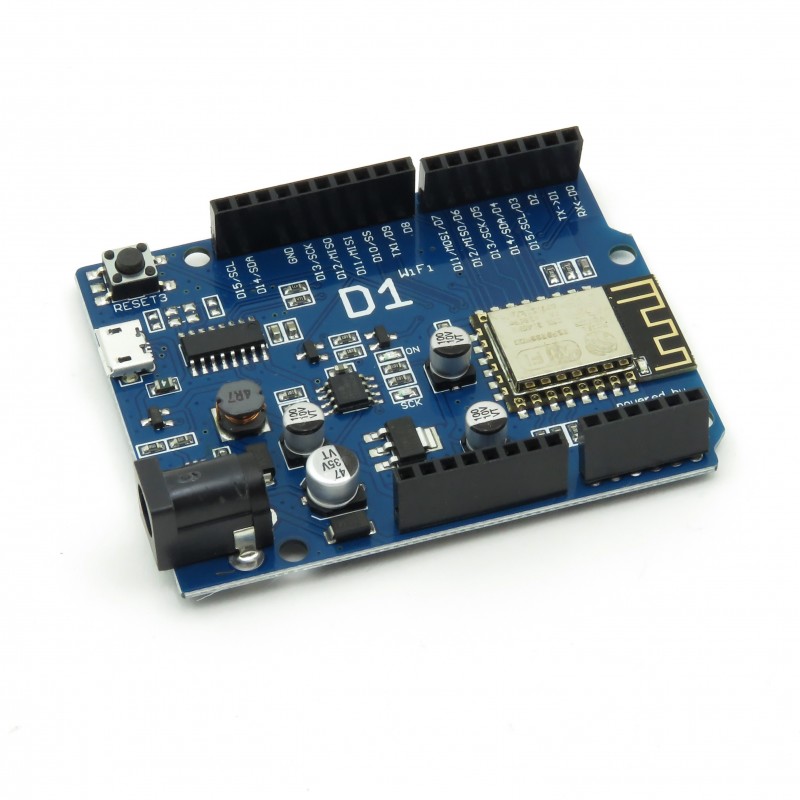




zł20.58 tax excl.
Development board with dimensions and spacing compatible with Arduino Uno R3. It have built-in Wi-Fi ESP8266 module. The device is compatible with WeDOS D1, it can be programmed from the level of Arduino IDE
Description
The development board allows for integration with Wi-Fi module (ESP8266) which is known for its simplicity and considerable capabilities with overlays (shields) with a spacing of connectors compatible with Arduino UNO R3 giving a lot of opportunities for the development of the IoT project. The board is compatible with WeMos D1 and NodeMCU.
Data sheet
Manufacturer BTC Korporacja sp. z o. o. Lwowska 5 05-120 Legionowo Poland sprzedaz@kamami.pl 22 767 36 20
Responsible person BTC Korporacja sp. z o. o. Lwowska 5 05-120 Legionowo Poland sprzedaz@kamami.pl 22 767 36 20
USB cable (type A) - microUSB (type B) used to connect the computer with devices equipped with microUSB-B sockets. Length: 1m
The 10 W AC adapter provides 5 V and 2 A current. It is equipped with a 1 m cable with microUSB plug. Akyga AK-TB-23
No product available!
A set with environmental sensors that allows you to measure air pollution and noise and visualize data on a dedicated platform. Seeed Studio 102110258
No product available!
Development board ESP8266 with WiFi module; WRL-13231
The module is based on the ESP8266MOD chip. Thanks to the support of the 802.11 b/g/n standard, it enables wireless communication with WiFi networks, which allows for Internet access and data exchange. WeMos D1 Mini Type-C
WiFi module with ESP8266 designed to work with the Raspberry Pi Pico. It communicates via the UART interface using AT commands. Waveshare Pico-ESP8266
WiFi 802.11 b/g/n module with ESP8266 system, 16 terminals are available with a 2 mm pitch with the possibility of soldering gold pins, there are 9 GPIO lines and 1 ADC line on the connector. Built-in ceramic antenna and U.FL antenna connector. ESP-07
Development board D1 Mini Pro with WiFi ESP8266 module and 16 MB Flash memory, equipped with ceramic antenna and external antenna connector. The module can be programmed from the Arduino IDE level. WeMos D1 Mini Pro
ESP-PROG is an advanced tool for programming and debugging Espressif microcontrollers such as ESP32, ESP32-C3, ESP32-S2, ESP32-S3 and ESP8266. With the built-in FT2232HL USB bridge, ESP-PROG converts the USB 2.0 interface to serial and parallel interfaces, offering functions of automatic firmware download, serial communication and online debugging via JTAG
Plate for applications in the area of Internet of Things (IoT). The module was based on the ESP8266 system, which integrates WiFi, TCP / IP communication, 32-bit MCU, 10-bit ADC and many interfaces such as HSPI, UART, PWM, I2C and I2S. DFrobot DFR0489
WiFi module based on ESP8266. The module has a built-in antenna and USB-UART converter. The module can be programmed in Lua (under the control of the NodeMCU firmware) or in the Arduino environment. 10 GPIO lines are available which each can be configured to work as PWM, I2C.
LoLin NodeMCU V3 is a board with ESP8266 (ESP12E). The ESP8266 system provides WiFi connectivity (802.11 b / g / n). The USB-UART converter (CH340G chip) is located on the board. The module can be programmed in Lua (under the control of the NodeMCU firmware) or in the Arduino environment. There are 10 GPIO lines available.
Easy to use app builder that allows users to add a variety of buttons, sliders, graphical displays and even RGB controllers to their phone. The SparkFun Blynk Board is specially designed to work with the ‘widgets’ within the Blynk mobile app to create your next IoT project. WRL-13794
Development board with ESP8266 microcontroller with built-in Wi-Fi communication. The system is clocked at 80 MHz and powered by 3.3 V. It includes a Tensillica core and a full Wi-Fi stack. Adafruit 3046
WiFi 802.11 b/g/n module with ESP8266 chip, there are 8 pins with UART and GPIO interface. Built-in PCB antenna. SparkFun WRL-17146
Module with round 1.28" IPS LCD display and 240x240 px resolution and ESP-12E chip. SB Components 24025
Adapter for ESP8266 modules dedicated to control addressable RGB LEDs from the WS2812 series
No product available!
This ESP8266-based development board is designed for rapid IoT application development. It features support for two Grove Plug-n-Play connectors, digital and analog I/O, and UART and I2C interfaces for connecting multiple sensors and modules. The device supports OTA firmware updates, a RESTful API, and integration with mobile apps and IFTTT, allowing for easy remote control and monitoring. Seeed Studio 102110057

Development board with dimensions and spacing compatible with Arduino Uno R3. It have built-in Wi-Fi ESP8266 module. The device is compatible with WeDOS D1, it can be programmed from the level of Arduino IDE
